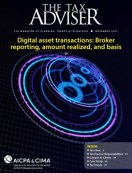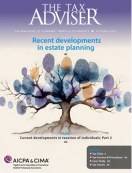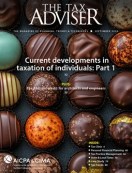- newsletter
- TAX INSIDER

Simplifying the Rube Goldberg tax code
Similar to a Rube Goldberg contraption, the Internal Revenue Code is needlessly complex. Here are a few ideas for simplification and a request for readers to suggest others.
Please note: This item is from our archives and was published in 2019. It is provided for historical reference. The content may be out of date and links may no longer function.
Related
IRS clarifies health savings account changes in H.R. 1 in new notice
IRS approves medical deduction for IVF, denies it for surrogacy
QSBS gets a makeover: What tax pros need to know about Sec. 1202’s new look
TOPICS
“Life is really simple, but we insist on making it complicated.” — attributed to Confucius
The income tax system is a montage of provisions piling upon provisions. Changes are made to fix the unintended consequences of earlier changes. Resourceful taxpayers and their advisers discover means (some valid, some not so valid) to avoid (if not evade) income taxes otherwise due. State legislatures spend time and resources to invent provisions designed to skirt the $10,000 limit on the deductibility of state and local taxes. It is as if Rube Goldberg, who often drew or invented complicated machines to perform simple tasks, were involved.
As businesses have evolved, so has the income tax system. Businesses that engineer processes and procedures to eliminate costs may thrive by what Joseph Schumpeter called “creative destruction,” but the Code grows ever more complex.
There are exceptions, of course. The expansion of taxpayers qualifying for the Sec. 448(c) cash method to those with average annual gross receipts of no more than $25 million, together with related exceptions from otherwise required accounting methods, substantially simplified compliance. In addition, qualifying businesses are not subject to the most complex change wrought by the law known as the Tax Cuts and Jobs Act (TCJA), P.L. 115-97: the Sec. 163(j) business interest limitation.
Rather than continuing a complex patchwork of provisions, the AICPA advocates for simplicity in the Code. The following are some ideas. None of them is significant, but each adds perhaps just a small element of simplicity.
Inflation-index self-employment tax earnings threshold
The $400 threshold for self-employment earnings has existed for decades, never indexed for inflation. If this figure had been indexed for inflation, $400 in 1969 would be $2,737 today (CPI-U data provided by the U.S. Department of Labor Bureau of Labor Statistics. Using 1980 as 100.0, 1969 was 36.7 and December 2018 was 251.107). Other threshold provisions in the Code are indexed for inflation. Sec. 1402(b)(2) should be indexed so that fewer self-employed individuals would be subject to this tax.
Estimated tax due dates
Estimated taxes are called quarterly estimates, but they aren’t due on a quarterly basis. Estimated taxes for individuals are due on the 15th day of the fourth, sixth, and ninth months, with the final estimate due the 15th day of the month following the end of the year. Let’s change this to the 15th day after the end of each calendar quarter.
Home office deduction de minimis use of room
The home office deduction rules for employees are simpler after the TCJA. Employees are no longer allowed to claim the deduction (what could be simpler?). Sole proprietors and partners of partnerships are subject to the rule requiring exclusive use of the office. Laptop computers and smart phones are rarely used exclusively for business and the same can be said for the home office space. It’s time to acknowledge that de minimis use exists; taxpayers should not be prohibited from the home office deduction due to small levels of nonbusiness use of the space.
Individuals allowed state and local tax deduction against business expenses
Business income generates business income tax liability. C corporations are allowed to deduct their state and local taxes, but individuals are not. The deductibility of nontax business expenses is the same, regardless of entity type. Income and other tax liabilities should be treated likewise. The tax liability associated with earning business income should be deductible above the line.
Health insurance costs should be deductible from self-employment income
Health insurance for employees is deductible for income tax purposes, and the deduction reduces income subject to self-employment tax. However, the sole proprietor and partner are not allowed to reduce self-employment income for their own health insurance. The deduction for the owner’s health insurance for self-employment tax purposes should be conformed to the income tax treatment. The deduction allowed under Sec. 162(l) should be available for self-employment tax purposes.
Simplify qualified retirement plan compliance for small businesses
Qualified retirement plans are subject to multiple limitations and discrimination rules. Small businesses are discouraged from adopting retirement plans due to the costs of complying with this complexity. Congress adopted simplified accounting method conventions for businesses with no more than $25 million average annual gross receipts (indexed). It’s time to provide similar simplification for qualified retirement plan compliance.
Repeal the individual AMT
Congress came close to fully repealing the alternative minimum tax (AMT). The AMT was repealed for C corporations. Because of a larger exemption amount, the number of individual taxpayers subject to the AMT is projected to decrease to 600,000, but many taxpayers still need to compute their alternative minimum taxable income to determine that they are not subject to the AMT (Joint Committee on Taxation, Overview of the Federal Tax System as in Effect for 2018 (JCX-3-18) (Feb. 7, 2018)). Full repeal will eliminate this problem.
Allow expensing of certain intangible costs
Taxpayers may deduct, rather than capitalize, up to $1 million (inflation indexed) of depreciable equipment costs under Sec. 179. However, capitalization is required for most intangibles. It’s time to expand full expensing for startup costs under Sec. 195 and organizational costs under Sec. 248, regardless of accumulated costs. Let’s expand the simplified accounting method conventions for small businesses (discussed above) to cover these costs, and costs of facilitating acquisitions.
Repeal the at-risk rules
The at-risk rules of Sec. 465 were added to the Code by Section 204(a) of the Tax Reform Act of 1976, P.L. 94-455. Although modified several times over the years, most of the regulations are in temporary or proposed status. Final regulations are out of date for subsequent changes. Informal advice from the IRS has noted that Tax Court rulings conflict with IRS positions on guarantees of debt (Field Service Advice 200025018; see also Chief Counsel Advice 201606027 reversed two months later by AM 2016-001). The ability to abuse the Code, which the at-risk rules were designed to prevent, has been reduced or eliminated through the Sec. 469 passive activity rules and the new excess business loss limitations of Sec. 461(l). It’s time to repeal the at-risk rules.
Let us know your thoughts on how the Code could be simplified. Remember, though, that a change that decreases tax collections should be combined with an offset so that projected deficits aren’t further increased.
“Everything should be made as simple as possible, but not simpler.” — attributed to Albert Einstein
For a complete description of these reform ideas and more, see the AICPA’s new position paper on Recommendations for Tax Law Changes to Reflect How Small Businesses Operate in the Modern World.
Christopher W. Hesse, CPA, is a principal in the National Tax Office of CLA (CliftonLarsonAllen LLP). He is the vice chair of the AICPA Tax Executive Committee. To comment on this article or to make suggestions for tax simplification, contact him at Chris.Hesse@CLAconnect.com. To suggest an idea for another article, contact senior editor Sally Schreiber at Sally.Schreiber@aicpa-cima.com.














